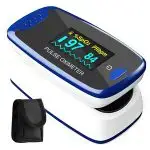

JUMPER Pulse Oximeter JPD-500D User Guide
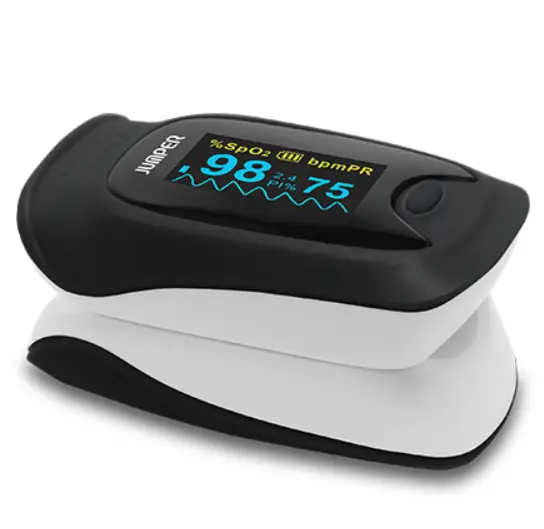
Precautions
- Do not attempt to maintain the Oximeter unless you are professional engineers. Only professionals with maintenance qualification are allowed to perform interior maintenance as necessary.
- Periodically change the contact position between the Oximeter probe and the finger for a measurement that lasts a long time. Adjust the position of the probe before the measurement lasts two hours, and check the integrity of skin, the blood circulation condition of the finger as well as the position of the finger.
- This product is not applicable to the examination of newborn babies.
- Seek for medical care in time if the measured value goes beyond the normal range while you are sure that the instrument does not malfunction.
- Do not directly expose your eyes to light-emitting components of the Oximeter, as that could cause harm to your eyes.
- For details about clinical limitations and contraindications, please carefully consult relevant medical literatures.
The following factors may cause disturbance to or affect the accuracy of examination:
- This product is used in an environment involving high-frequency devices, such as high-frequency electric knives and CT apparatuses.
- The probe of the Oximeter is placed on the same body part or limb as with blood pressure cuff arterial duct or intravenous injection.
- The user suffers from hypotension, severe vascular atrophy, severe anemia, or low oxygen.
- The user is in sudden cardiac arrest or shock state.
- The finger with nail polish or a fake fingernail may cause wrong readings of pulse oxygen saturation.
Warnings
Warning: Do not use the Oximeter in an environment with any inflammable gases, inflammable anesthetic, or other inflammable substances.
Warning: Do not attempt to charge any common dry battery, as that could cause leakage, fire disaster, or even explosion. Dispose of exhausted batteries in accordance with environment protection regulations.
Warning: Do not use the Oximeter in an MRI or CT environment.
Warning: Do not operate the Oximeter when it is damp with overflow or water vapor condensation. Avoid moving the Oximeter from an excessively-cold environment to a high-temperature moist environment.
Symbol Conventions

Overview
Oxygen saturation is the percentage of oxyhemoglobin (HbO2) that is combined with oxygen against all combinable hemoglobin (Hb). It is an important physiological parameter involved in respiration and circulation. The oxygen saturation of arterial blood in a normal human body is 98%. Oxygen saturation is an important indicator of the oxygen condition in the human body. In general, the normal values of oxygen saturation shall not be lower than 94%. If the measured value of oxygen saturation is lower than 94%, an insufficient supply of oxygen is considered.
The pulse rate is the number of pulse beats per minute. Normally, the pulse rate is consistent with the heart rate. In general, the pulse rate of every people is 60 to 90 beats per minute.
The Perfusion Index (PI) usually reflects the limb perfusion status of an examined patient, and shows the detection precision of the instrument as well; that is, examination can still be performed even in the low or weak perfusion condition.The PI of a normal human body is 3% or greater.
Working Principles, Expected Usage, and Applicable Scope
Based on full digital technology, the Finger Pulse Oximeter non-invasively measures the actual content (oxygen saturation) of oxyhemoglobin (HbO2) in arterial blood using the optical transmittance method.
The Finger Pulse Oximeter measures the blood oxygen saturation and pulse rate of a human body via finger artery. It is applicable to a wide range of fields, such as families, hospitals (including operation rooms of the departments of internal medicine and surgery, the department of anesthesiology, the department of paediatrics, and intensive care rooms), oxygen bars, social medical care institutions, and sports & health. Use this instrument for measurement before or after sports. You are not advised to use this instrument during sports activities. Do not use it for
continuous care for patients.
Appearance of the structure
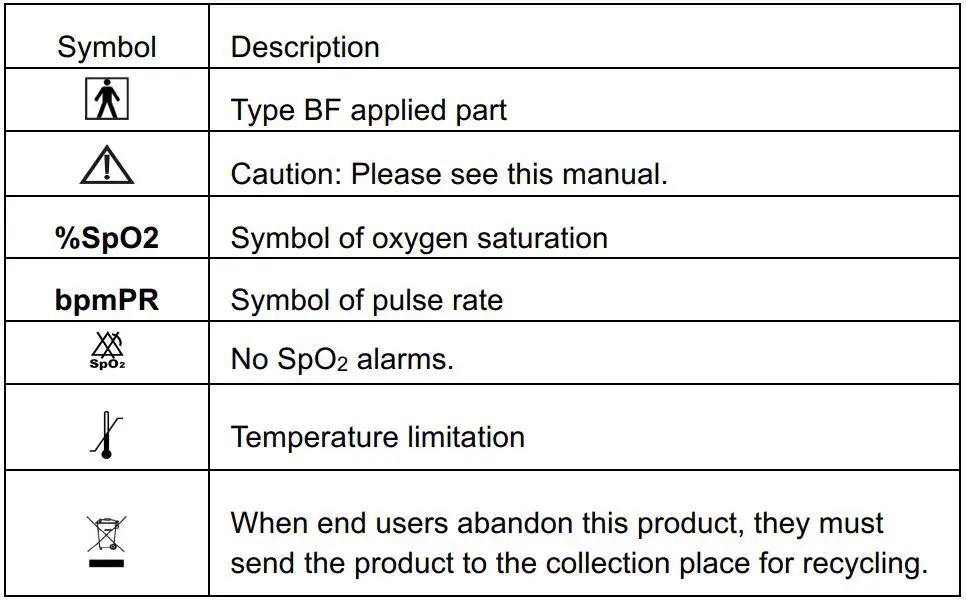
Screen Display
The following figure shows the information display on the OLED screen of the Oximeter in normal detection state:

Power-On button/Functional button Operations
Press and release the button to turn on, hold the button for about one second. The Oximeter shows a parameter setting interface. Press or hold the button to perform corresponding operations. Hold it to set an item, or press it to switch an option or switch the display mode. Press means no more than 0.5 seconds, while Hold means more than 0.5 seconds.
Alert Sound Setting
Hold the functional button while the Oximeter is in powered-on state. Parameter setting interface 1 is displayed, as shown in the following figure. Move “*” to the corresponding option, and hold the functional button to set Alm to on and set Beep to off. When Alm is set to on and the measured values of the blood oxygen saturation and pulse rate go beyond the upper limit or lower limit, the Oximeter gives off an alert sound. When Alm is set to off and the measured values go beyond the limit, the Oximeter will not give any alert sound. When Beep is set to on, a tick will be heard along with pulse beats during pulse rate measurement. When Beep is set to off, no sound will be output along with pulse beats during pulse rate measurement. While the “*” symbol stays on the Restore option, hold the functional button to restore factory settings.
Brightness Setting
On parameter interface 1, press the functional button to select the Brightness option and then hold the functional button to set the brightness to a value ranging from 1 to 5. The greater the value, the greater the brightness of the screen.
Alert Range Setting
On parameter interface 2, press the functional button to switch between options. On this interface, you can set the upper limit and lower limit of SpO2 Alm and PR Alm. While the “*” symbol stays on the +/- option, hold the functional button to set the option to + or -. In + mode, select the corresponding option and hold the functional button to increment the upper or lower limit; in – mode, hold the functional button to decrement the upper or lower limit. Move “*” to the Exit option, and hold the functional button to return to the monitoring interface.

Operation Guide
Stick one finger completely into the measuring parts of the Oximeter, keep the fingernail surface upward, and release the clip. Then press the power button to power on the Oximeter.

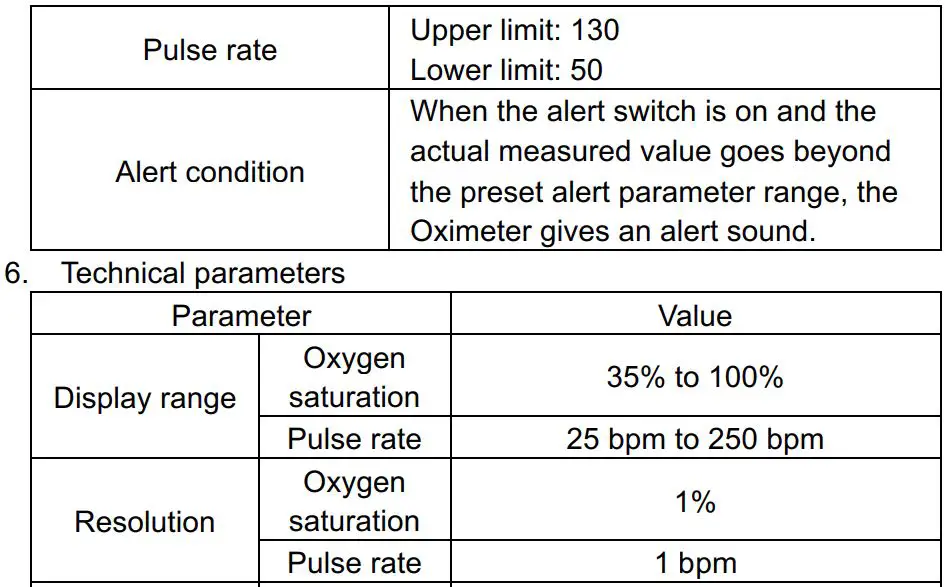 If you do not yet completely insert your finger into the cavity, the measurement result may be inaccurate.
If you do not yet completely insert your finger into the cavity, the measurement result may be inaccurate.
 Do not vibrate your finger during measurement. ensure that your body does not move. After the readings become stable, read the measured values of oxygen saturation and the pulse rate on the screen.
Do not vibrate your finger during measurement. ensure that your body does not move. After the readings become stable, read the measured values of oxygen saturation and the pulse rate on the screen.
NOTE: The Oximeter will automatically shut down 10 seconds later after your finger leaves away.
About the Display
Continuously press the functional button in the monitoring process. The monitored data and the display mode will be cyclically displayed on the OLED screen in two different ways (large fonts and plethysmogram) and four directions, as shown in the following figure.
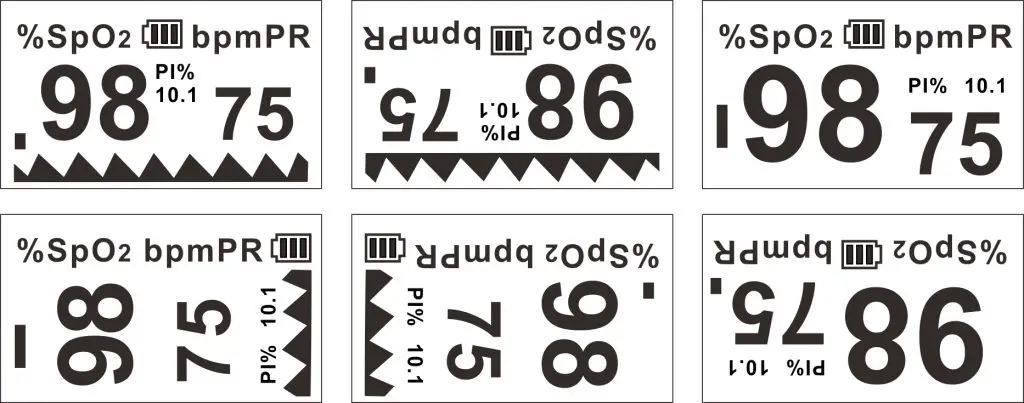
 Replace the batteries when the battery capacity is insufficient and the symbol
Replace the batteries when the battery capacity is insufficient and the symbol  flickers on the screen. Open the battery cover with your fingers, you can replace the batteries according to the correct battery polarity.
flickers on the screen. Open the battery cover with your fingers, you can replace the batteries according to the correct battery polarity.
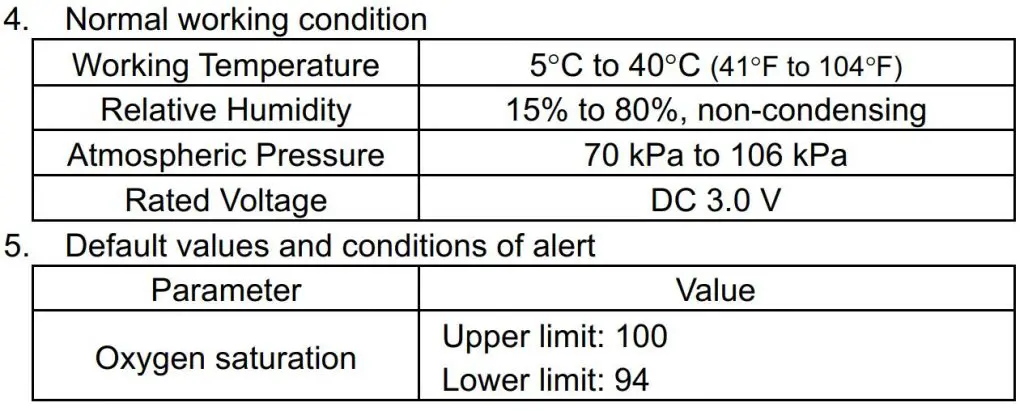
Cleaning
Power off the instrument and remove the batteries before cleaning. Ensure that the appearance of the instrument is neat, dust-free, and dirt-free. Clean the outer surface of the instrument (including the OLED screen) using 75% medical alcohol and a piece of dry soft cloth.
Caution: Avoid liquid flowing into the instrument during cleaning.
Caution: Do not immerse any part of the instrument into any liquid.
Disinfection
Before measurement with the instrument, wipe the rubber finger pad using a piece of dry soft cloth dipped with 75% medical alcohol. Clean the finger to be measured using the medical alcohol for disinfection purposes before and after use.
 Do not disinfect the instrument by means of high-temperature, high-pressure or gas disinfection.
Do not disinfect the instrument by means of high-temperature, high-pressure or gas disinfection.
Maintenance
- Remove the batteries from the battery slot and properly store them if you do not plan to use the Oximeter for a long period of time.
- Avoid using the Oximeter in an environment with inflammable gases or using it in an environment where the temperature or humidity is excessively high or low.
- Check the accuracy of the oxygen saturation and pulse rate readings by using an appropriate calibration apparatus.
Technical Specifications
- Dimensions: 62.2 mm (Width) × 37.0 mm (Depth) × 33.1 mm (Height) Weight: 42.5 g (including two AAA dry batteries)
- Peak wavelength range of the light emitted from the probe: red light 660 nm ± 3; infrared light 905 nm ± 5.
- Maximum optical output power of the probe: 1.2 mW for infrared light (905 nm).
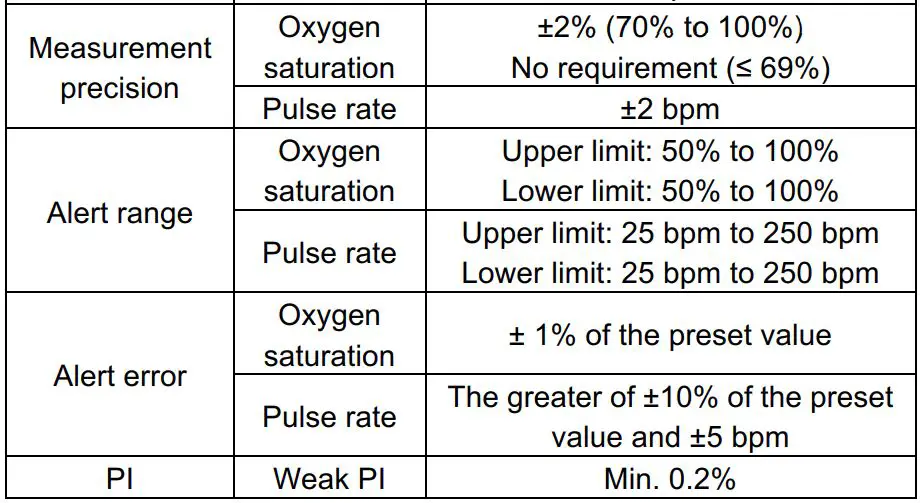


Safety Type
Anti-electric-shock type: internal power supply device
Anti-electric-shock degree: Type BF applied part
Running mode: continuous working
Waterproof grade: IP22
Storage and Transportation

 Wellkang Ltd
Wellkang Ltd
Suite B, 29Harley Street, LONDON, W1G9QR,U.K.
 Shenzhen Jumper Medical Equipment Co., Ltd
Shenzhen Jumper Medical Equipment Co., Ltd
Address: D Building, No. 71, Xintian Road, Fuyong Street,
Baoan,Shenzhen, Guangdong,China
E-mail: [email protected]
Tel: +86-755-26692192,26696279
Web: www.jumper-medical.com